Section 4 Limits and Sequences
Real analysis is, in a way, the study of the mathematics that makes calculus possible. In the introduction to Section 3 we described how inequalities are one pathway to constructing the real numbers; the other, sequences, you've had experience with in your calculus classes that we recall here.
Subsection 4.1 Sequences
Definition 4.1. Sequence.
A sequence of real numbers is a function \(a \colon \mathbb{N}\to \mathbb{R}\text{.}\) We usually use subscript rather than function notation for sequences, writing \(a_1\) instead of \(a(1)\text{,}\) \(a_2\) instead of \(a(2)\text{,}\) and so on.
Many sequences can be understood as “points on the graph” of a function \(f\colon \mathbb{R} \to \mathbb{R}\text{,}\) and this can help us to understand how the sequence behaves. Not every sequence makes this easy: factors like \((-1)^n\) or \(n!\) don't generalize easily to all real numbers.
Remark 4.2.
The sequence \(a_n = \displaystyle\frac{2n}{3n-10}\) can be thought of as the points on the graph of the function \(f(x) = \displaystyle\frac{2x}{3x-10}\) whose \(x\)-coordinates are natural numbers, such as in the graph pictured below.
One of the most important questions we ask about sequences in calculus is: do they “converge”? That is, do the values of \(a_1,a_2,a_3,\ldots,a_n,a_{n+1},\ldots\) “tend toward” a single real number \(L\) as \(n\to\infty\text{?}\) The following definition may or may not be new to you; it is one of the most important definitions that you will study in real analysis.
Definition 4.4. Limit of a Sequence.
Let \(a_n\) be a sequence of real numbers, and let \(L\in\mathbb{R}\text{.}\) We say that \(a_n\) converges to \(L\text{,}\) and write \(\displaystyle\lim_{n\to\infty} a_n = L\text{,}\) if:
This definition will be challenging at first to understand, unpack, and use in a proof. This example can help build intuition for the meaning of its various pieces.
Remark 4.5.
Consider the sequence \(a_n=\displaystyle\frac{(-1)^n}{n}\text{.}\)
The sequence \(a_n\) converges to a limit of \(L=0\text{.}\) For any \(\epsilon \gt 0\) we can choose, no matter how small, there is a natural number \(N\) so that all of the points in the sequence “after” \(N\) (that is, all \(a_n\) with \(n\geq N\)) lie inside the yellow band \(0-\epsilon \lt y \lt 0+\epsilon\) on the graph.
Subsection 4.2 Finding Limits
One tricky part about using Definition 4.4 is that the definition does not help you actually find the value of the limit \(L\) of a convergent sequence. For that, we have some tools from calculus that often help.
Definition 4.7. Geometric Sequence.
A sequence \(a_n\) is called geometric if there exists a real number \(r\in\mathbb{R}\) such that
The number \(r\) is called the “common ratio” of the sequence.
Theorem 4.8.
A geometric sequence \(a_n = r^n\) converges to 0 if and only if \(|r|\lt 1\text{.}\)
If \(r \gt 1\text{,}\) the sequence \(a_n\) approaches \(+\infty\text{.}\)
The following two theorems apply to finding the limits of functions in calculus, and can be used for limits of sequences as well when those sequences generalize to functions of a real variable.
Theorem 4.9. Squeeze Theorem.
Let \(a_n,b_n,c_n\) be three sequences of real numbers. If there exists a natural number \(N\) such that
and if \(\displaystyle\lim_{n\to\infty} a_n = L = \displaystyle\lim_{n\to\infty} c_n\text{,}\) then the sequence \(b_n\) converges and has limit \(L\) as well.
Remark 4.10.
To use the squeeze theorem to determine the limit of a sequence, find both a greater and a smaller sequence than the one in question, such that both have the same limit. Then the sequence “in between” them converges to the same limit.
The sequence \(b_n = \displaystyle\frac{\sin(n)}{n^2}\) can be studied in this way. Since for all \(n\) we know \(-1\leq \sin(n) \leq 1\text{,}\) we also know for all \(n\) that
Since both \(a_n=-1/n^2\) and \(c_n=1/n^2\) converge to zero, so does \(b_n\text{.}\)
Many sequences (and functions) of interest have limits that, on their face, take one of the indeterminate forms
These limits can be evaluated through the use of l'Hopital's rule. You can read more about l'Hopital's rule in calculus texts such as this one.
Theorem 4.11. l'Hopital's Rule.
Let \(f,g\colon \mathbb{R}\to\mathbb{R}\) be two functions which are differentiable at \(x=a\text{.}\) If
then the limit of their quotient is the limit of their derivatives' quotient:
If there exists a real number \(B\) such that \(f,g\) are differentiable for all \(x\geq B\text{,}\) then (4.2) may be applied to the limit toward \(a=\infty\text{.}\)
The above also applies for the indeterminate form \(\infty/\infty\text{,}\) that is, the case in which \(\lim_{x\to a}f(x) = \infty = \lim_{x\to a} g(x)\text{.}\)
Remark 4.12.
We can use l'Hopital's rule to find the limit of the sequence \(a_n=\displaystyle\frac{n^2+2}{2n^2+3n}\text{,}\) which is the same as the limit of the function \(f(x) = \displaystyle\frac{x^2+2}{2x^2+3x}\) as \(x\to\infty\text{,}\) since it has the indeterminate form \(\infty/\infty\text{:}\)
Warning 4.13.
The following limit forms are not indeterminate, so l'Hopital's rule cannot be used to find their limits.
Worksheet 4.3 Limits and Sequences Workbook
1.
Draw a graph to represent the limit for the sequence \(b_n=\displaystyle\frac{1}{n}\text{.}\)
2.
Draw a graph to represent the limit for the sequence \(c_n = \displaystyle\frac{(-1)^n}{n!}\text{.}\) (Recall \(n!\) is “\(n\) factorial”.)
3.
Find the limit of the function: \(\displaystyle\lim_{x\to 1} \displaystyle\frac{e^{x-1}}{3}\)
4.
Find the limit of the function: \(\displaystyle\lim_{x\to 0} \displaystyle\frac{\sin^2(x)}{x^2}\)
In #5-12, find the limit of each sequence, or justify why it does not exist.
5.
\(y_n=\displaystyle\frac{n}{2^n}\)
6.
\(a_n=\displaystyle\frac{2^n}{3^{n+1}}\)
Manipulate the expression using exponent rules, and use facts about geometric sequences.
7.
\(c_n = \displaystyle\frac{\cos^2(n)}{2^n}\)
Use the squeeze theorem.
8.
\(b_n = \sqrt{n+3} - \sqrt{n}\)
Use the conjugate method: try multiplying by the quantity \(\displaystyle\frac{\sqrt{n+3} + \sqrt{n}}{\sqrt{n+3}+\sqrt{n}}\) and see what happens.
9.
\(k_n = (1.01)^n\)
10.
\(a_n = e^{\frac{4n}{3n+1}}\)
You can take the limit inside the exponent, but it is worth thinking about why.
11.
\(b_n = \sqrt{4+\frac{1}{n}}\)
You can take the limit inside the exponent, but it is worth thinking about why.
12.
\(d_n = \displaystyle\frac{4+n-3n^2}{4n^2-1}\)
